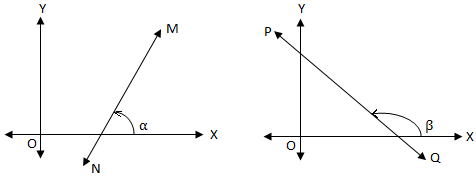Subscribe to our ▶️ YouTube channel 🔴 for the latest videos, updates, and tips.
Slope of a Straight Line
What is slope of a straight line?
The tangent value of any trigonometric angle that a straight line makes with the positive direction of the x-axis in anticlockwise direction is called the slope or gradient of a straight line.
The angle of inclination of a line is the angle made by the line with the positive direction of the x-axis. It is usually measured from the positive x-axis in the anti-clockwise direction.
The slope of the line is generally denoted by ‘m’. Thus, m = tan θ. The gradient or slope of a line (not parallel to the axis of y) is the trigonometrical tangent of the angle which the line makes with the positive direction of the x-axis. Thus, if a line makes an angle θ with the positive direction of the x-axis, then its slope will be tan θ. The slop of a line is positive or negative according as θ is acute or obtuse. Sine a line parallel to x-axis makes an angle of 0° with x-axis, therefore its slope is tan 0° = 0. A line parallel to y-axis that is i.e., perpendicular to x-axis makes an angle of 90° with x-axis, so its slope is tan \(\frac{π}{2}\) = infinity. Also the slope of a line equally inclined with axes is 1 or -1 as it makes 45° or 135° angle with x-axis.
In short, the slope of a line is the trigonometrical tangent of its inclination.
In the above figure the inclination of the lines MN and PQ are α and β respectively.
Solved examples to find the slope of a straight line:
1. Find the slope or gradient of a straight line whose inclination to the positive (+ve) direction of x-axis in anticlockwise direction is
(i) 30°
(ii) 0°
(iii) 45°
(iv) 135°
Solution:
(i) 30°
Slope or gradient = tan 30° = \(\frac{1}{√3}\)
(ii) 0°
Slope or gradient = tan 0° = 0
(iii) 45°
Slope or gradient = tan 45° = 1
(iv) 135°
Slope or gradient = tan 135° = -cot 40° = -1
2. What can be said regarding a line if its Slope or gradient is
(i) (+ve)
(ii) Zero (0)
(iii) (-ve)
Solution:
Let ∅ be the angle of inclination of the given straight line with the positive (+ve) direction of x-axis in anticlockwise direction. Then its Slope or gradient is given by m = tan ∅.
(i) Slope or gradient is positive (+ve)
⇒ m = tan ∅ > 0
⇒ ∅ lies between 0° and 90°
⇒ ∅ is an acute angle.
(ii) Slope or gradient is zero (0)
⇒ m = tan ∅ = 0
⇒ ∅ = 0°
⇒ either the line is x-axis or is parallel to x-axis.
(iii) Slope or gradient is negative (-ve)
⇒ m = tan ∅ < 0
⇒ ∅ lies between 0° and 180°
⇒ ∅ is an obtuse angle.
● The Straight Line
- Straight Line
- Slope of a Straight Line
- Slope of a Line through Two Given Points
- Collinearity of Three Points
- Equation of a Line Parallel to x-axis
- Equation of a Line Parallel to y-axis
- Slope-intercept Form
- Point-slope Form
- Straight line in Two-point Form
- Straight Line in Intercept Form
- Straight Line in Normal Form
- General Form into Slope-intercept Form
- General Form into Intercept Form
- General Form into Normal Form
- Point of Intersection of Two Lines
- Concurrency of Three Lines
- Angle between Two Straight Lines
- Condition of Parallelism of Lines
- Equation of a Line Parallel to a Line
- Condition of Perpendicularity of Two Lines
- Equation of a Line Perpendicular to a Line
- Identical Straight Lines
- Position of a Point Relative to a Line
- Distance of a Point from a Straight Line
- Equations of the Bisectors of the Angles between Two Straight Lines
- Bisector of the Angle which Contains the Origin
- Straight Line Formulae
- Problems on Straight Lines
- Word Problems on Straight Lines
- Problems on Slope and Intercept
11 and 12 Grade Math
From Slope of a Straight Line to HOME PAGE
Didn't find what you were looking for? Or want to know more information about Math Only Math. Use this Google Search to find what you need.



New! Comments
Have your say about what you just read! Leave me a comment in the box below. Ask a Question or Answer a Question.